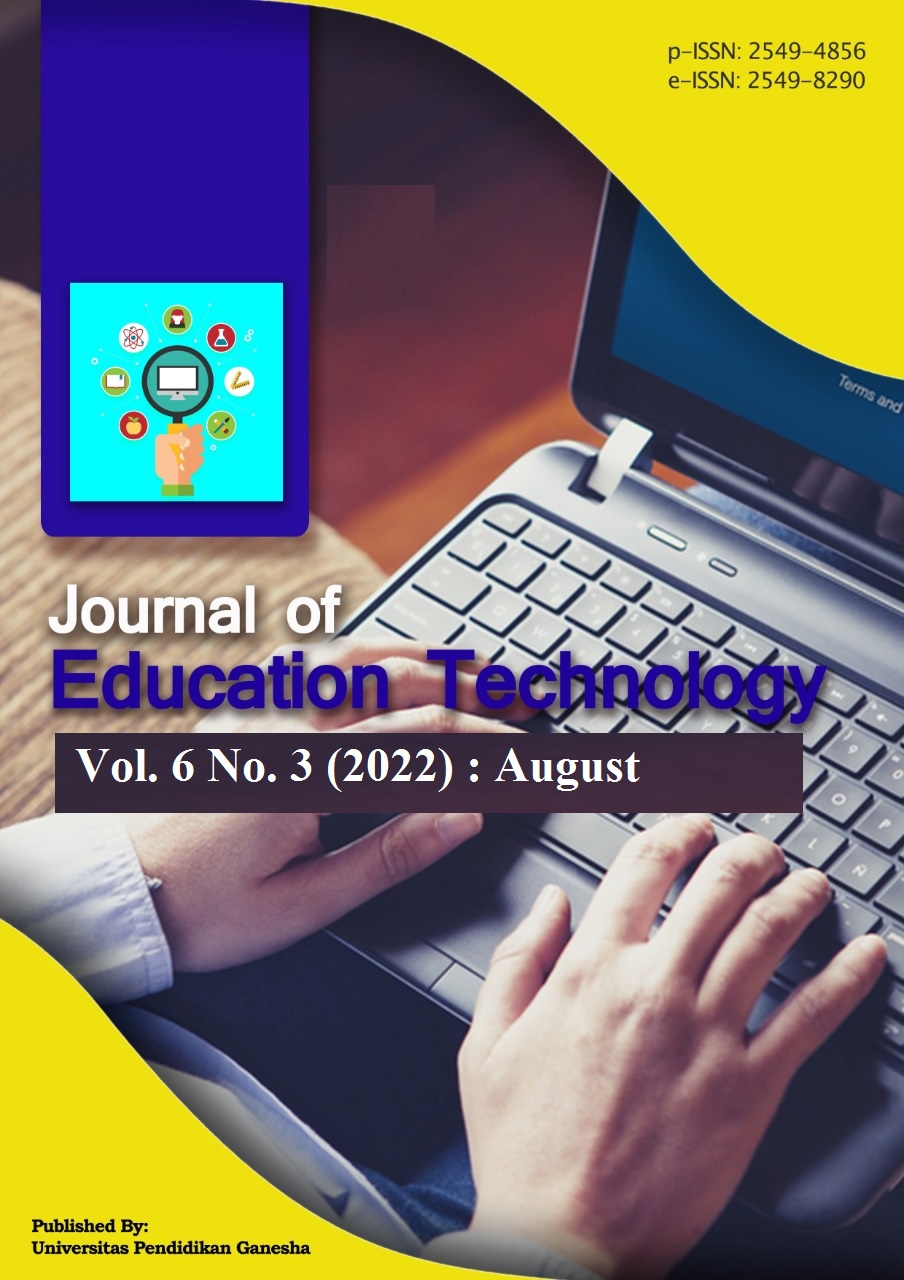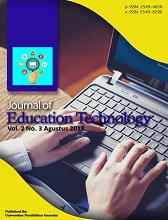The Effect of English Authentic Youtube Videos on Students' Speaking Skills in Rural School
DOI:
https://doi.org/10.23887/jet.v6i3.45412Kata Kunci:
Speaking skill, YouTube Videos, Language Learning Media, AccuracyAbstrak
Technology expands students' opportunities for authentic interaction with native speakers and other language learners at various levels, both inside and outside of the classroom. The purpose of this research is to examine an improvement in students' speaking skills in terms of fluency, vocabulary, grammar, pronunciation, and accuracy by using English YouTube videos, as well as the impact on students' speaking skills with a civil and non civil servant's family background in rural school. In this study, a quantitative method with a true experimental design was used, and a total of N=90 students participated, with N=50 students chosen using purposive sampling from two different classes to serve as samples. The instrument for the study included tests, a pre-test, and a post-test. The data was then analysed statistically to determine the results of the given pre-test and post-test. The average score increased after the post-test in terms of receiving results in terms of improving students' English speaking. Accuracy turned out to be one of the most important aspects of speaking that improved markedly. It means that students learned from native speakers through English YouTube videos, and their accuracy has enormously improved as a result. Meanwhile, students from civil servant families scored 95 on the post-test, while students from non-civil servant families scored 92.5. It was discovered that there is only a minor difference in improvement between civil and non-civil servant students' backgrounds. Teachers should consider using authentic English YouTube videos in the classroom to assist children of their English speaking skills.
Referensi
Abdulrahman Almurashi, W. (2016). The Effective Use of Youtube Videos for Teaching English. International Journal of English Language and Linguistics Research, 4(3). https://doi.org/10.5296/jsel.v4i1.9423.
Ahmad, J. (2017). Technology assisted language learning is a silver bullet for enhancing language competence and performance: A case study. International Journal of Applied Linguistics and English Literature, 5(7). https://doi.org/10.29333/ijale.2017.13a.
Anggraini, A. (2021). Improving Student’s Speaking Skill Using Youtube Video as Media: An Action Research. Scope : Journal of English Language Teaching, 5(2). https://doi.org/10.30998/scope.v5i2.8406.
Anrasiyana, A., Sulistyaningsih, S., & Syakur, A. (2022). Creating Vlog as Media in English Language Teaching (ELT): Teaching Speaking. Journal Basicedu, 6(2). https://doi.org/10.31004/basicedu.v6i2.2575.
Arib, A. W. (2017). Do Family Backgrounds Control Students’ Motivation and Achievement in Learning a Foreign Language? The Case of One Islamic Senior High School in Jambi. Ta’dib, 22(1). https://doi.org/10.19109/td.v22i1.1622.
Arif, T. Z. Z. A. (2020). The Influences of Audio Visual Media and Vocabulary Mastery towards English Learning Achievement of EFL Students. Journal of English for Academic Purposes, 7(1). https://doi.org/10.25299/jshmic.2020.vol7(1).3905.
Ariyanto, N., Rochsantiningsih, D., & Pudjobroto, H. (2018). Enhancing Students’ Speaking Skill by Using Youtube Video. English Education, 6(3). https://doi.org/10.20961/eed.v6i3.35883.
Ayu, D., Handayani, P., Gede, D., & Wirabrata, F. (2020). How Parents’Academic Background Can Affect Parental Involvement in Preschooler ’ S Education. Journal of Contemporary Research American international, 8(1). https://doi.org/10.23887/paud.v8i1.24560.
Bakar, S., Aminullah, R., & Sahidol, J. N. (2019). Using YouTube to Encourage English Learning in ESL Classrooms. Springer Nature Singapore. https://doi.org/10.1007/978-981-13-0203-9_38.
Bunujevac, M., & Durisic, M. (2017). Parental Involvement as a Important Factor for Successful Education. CEPS Journal, 7(3). https://doi.org/10.26529/cepsj.291.
Cahyana, A. A. C. (2020). The use of Youtube Video in Teaching English for Foreign Langauge at Vocational High School. Jurnal Pendidikan Bahasa Inggris, 8(2). https://doi.org/10.23887/jpbi.v8i2.3399.
Feng, H., & Liu, H. (2021). International Perspectives on Teaching the Four Skills in ELT: Listening, Speaking, Reading, Writing, Anne Burns, Joseph Siegel, Palgrave Macmillan, Cham (2018), xiv + 260 pp. System, 98. https://doi.org/10.1016/j.system.2021.102467.
Fikri, M., Ananda, M. Z., & Faizah, N. (2021). Kendala Dalam Pembelajaran Jarak Jauh di Masa Pandemi Covid-19 : Sebuah Kajian Kritis. Jurnal Education and development, 9(1), 145–148. https://doi.org/10.37081/ed.v9i1.2290.
Hamad, M. M., Metwally, A. A., & Alfaruque, S. Y. (2019). The Impact of Using YouTubes and Audio Tracks Imitation YATI on Improving Speaking Skills of EFL Learners. English Language Teaching, 12(6). https://doi.org/10.5539/elt.v12n6p191.
Hendriwanto, Desela, T. D., & Sharda, R. S. (2021). Exploring the University Students’ Experience in Learning English from Youtubers. Academic Journal PERSPECTIVE: Language, 9(2). https://doi.org/10.33603/perspective.v9i2.6089.
Hussaeni, S., Pratama, H., Arifin, R. A., Winda, A., & Widianingsih, S. (2020). The Use of YouTube as a Learning Tool in Teaching Listening Skill. International Journal of Global Operation Reserch, 1(3), 123–129. https://doi.org/10.47194/ijgor.v1i3.50.
Jackman, W. M. (2019). YouTube usage in the university classroom: An argument for its pedagogical benefits. International Journal of Emerging Technologies in Learning, 14(9). https://doi.org/10.3991/IJET.V14I09.10475.
Kamelia, K. (2019). Using Video as Media of Teaching in English Language Classroom: Expressing Congratulation and Hopes. Utamax : Journal of Ultimate Research and Trends in Education, 1(1), 34–38. https://doi.org/10.31849/utamax.v1i1.2742.
Karimy, S., & Pishkar, K. (2017). The Relationship among ELT Students ’ Speaking Accuracy and Fluency and Teachers ’ Oral Skill Class Presentation. Journal of Applied Linguistics and Language Research, 4(2). https://doi.org/10.3991/JALLR.V14I09.47.
Khalid, A., & Muhammad, K. (2012). The Use of YouTube in Teaching English Literature The Case of Al-Majma ’ ah Community College , Al-Majma ’ ah University ( Case Study ). International Journal of Linguistics, 4(4), 525–551. https://doi.org/10.5296/ijl.v4i4.2930.
Kristiani, P. E., & Pradnyadewi, D. A. M. (2021). Effectiveness of YouTube as Learning Media in Improving Learners’ Speaking Skills. The Art of Teaching English as a Foreign Language, 1(2). https://doi.org/10.36663/tatefl.v1i2.97.
Kurniawati, D. (2016). The Use of Video to Enhance the Teaching and Learning Process of Listening English for University Students. English Education Journal, 9(2), 276–289. https://doi.org/10.24042/ee-jtbi.v9i2.373.
Liyana, A., & Kurniawan, M. (2019). Speaking Pyramid sebagai Media Pembelajaran Kosa Kata Bahasa Inggris Anak Usia 5-6 Tahun. Jurnal Obsesi : Jurnal Pendidikan Anak Usia Dini, 3(1). https://doi.org/10.31004/obsesi.v3i1.178.
Maziriri, E. T., Gapa, P., & Chuchu, T. (2020). Student perceptions towards the use of youtube as an educational tool for learning and tutorials. International Journal of Instruction, 13(2). https://doi.org/10.29333/iji.2020.1329a.
Meinawati, E., Rahmah, N. A., & Harmoko, D. D. (2020). Increasing english speaking skills through youtube. POLYGOT: Jurnal Ilmiah, 16(1). https://doi.org/10.19166/pji.v16i1.1954.
Miller, B. (2017). YouTube as Educator: A Content Analysis of Issues, Themes, and the Educational Values of TransgenderCreated Online Videos. Social Media and Society, 3(2). https://doi.org/10.1177/2056305117716271.
Muslem, A., Fata, I. ., & Inayatullah, I. (2019). Factors Affecting Internship Students’ Speaking Anxiety. Al-Ta lim Journal, 26(2). https://doi.org/10.15548/jt.v26i2.531.
Nasution, A. K. R. (2019). YouTube as a Media in English Language Teaching ( ELT ) Context : Teaching Procedure Text. 1(1), 29–33.
Nofrika, I. (2019). EFL Students’ Voices: The Role of YouTube in Developing English Competences. Journal of Foreign Languange Teaching and Learning, 4(1). https://doi.org/10.18196/ftl.4138.
Pinandhita, F., bin Mohd Yasin, M. H., & Yusuf, M. (2022). Underpinning EFL Students’ Speaking Skill Through Affective and Social Language Learning Strategy at University in Indonesia. In 2nd International Conference on Education and Technology (ICETECH). https://doi.org/10.2991/assehr.k.220103.022.
Pratama, E. (2018). Using video blogging as an appropriate media for teaching English: bring a live classroom. English Journal, 12(1). https://doi.org/10.32832/english.v12i1.3770.
Primasari, I. F. N. D., & , Zulela, F. (2019). Model Mathematics Realistic Education (RME) Pada Materi Pecahan di Sekolah Dasar. Jurnal Basicedu, 1(1), 1–9. https://doi.org/10.31004/basicedu.v5i4.1115.
Rachmijati, C. (2019). Implementation of blended learning through youtube media to improve students’ speaking skill. Journal of Language studies, 13(2). https://doi.org/10.19105/ojbs.v13i2.2424.
Saed, H. A., Haider, A. S., Al-Salman, S., & Hussein, R. F. (2021). The use of YouTube in developing the speaking skills of Jordanian EFL university students. Heliyon, 7(7). https://doi.org/10.1016/j.heliyon.2021.e07543.
Sari, A. B. P., Dardjito, H., & Azizah, D. M. (2020). EFL students’ improvement through the reflective youtube video project. International Journal of Instruction, 13(4). https://doi.org/10.29333/iji.2020.13425a.
Sharma, P. (2020). A Paper on teaching English to Underprivileged Learners. International Journal of Interdisciplinary Research, 18(1). https://doi.org/10.13140/RG.2.2.26666.64965.
Syafiq, A. N., Rahmawati, A., Anwari, & Oktaviana, T. (2021). Increasing speaking skill through youtube video as English learning material during online learning in pandemic covid-19. ELSYA: Journal of English Language Studies, 3(1). https://doi.org/10.31849/elsya.v3i1.6206.
Wang, H. C., & Chen, C. W. (2020). Learning English from YouTubers: English L2 learners’ self-regulated language learning on YouTube. Innovation in Language Learning and Teaching, 14(4). https://doi.org/10.1080/17501229.2019.1607356.
Wang, J. (2019). Connecting rural schools to quality education: Rural teachers’ use of digital educational resources. Computers in Human Behaviour, 101. https://doi.org/10.1016/j.chb.2019.07.009.
Yacoob, Z., & Saad, N. H. (2020). Acceptance of youtube as a learning platform during the covid-19 pandemic: the moderating effect of subscription status. TEM Journal, 9(4). https://doi.org/10.18421/TEM94‐54.
Yudar, R. S., Aditomo, D. T., & Silahahi, N. S. (2020). The movie as a helper for students’ pronunciation in speaking skill class. ELSYA: Journal of English Language Studies, 2(1). https://doi.org/10.31849/elsya.v2i1.3684.
Yukselir, C., & Komur, S. (2017). Using online videos to improve speaking abilities of efl learners. European Journal of Education Studies, 3(5). https://doi.org/10.5281/zenodo.495750.
Zhao, Q. (2021). Research on the influence of Computer Information Technology on Rural Preschool Education. Journal of Physics: Conference Series. https://doi.org/10.1088/1742-6596/1915/3/032066.
Unduhan
Diterbitkan
Cara Mengutip
Terbitan
Bagian
Lisensi
Hak Cipta (c) 2022 Asnawi Muslem, Ika Apriani Fata, Windy Ilan Saputri

Artikel ini berlisensiCreative Commons Attribution-ShareAlike 4.0 International License.
Authors who publish with the Journal of Education Technology agree to the following terms:
- Authors retain copyright and grant the journal the right of first publication with the work simultaneously licensed under a Creative Commons Attribution License (CC BY-SA 4.0) that allows others to share the work with an acknowledgment of the work's authorship and initial publication in this journal.
- Authors are able to enter into separate, additional contractual arrangements for the non-exclusive distribution of the journal's published version of the work (e.g., post it to an institutional repository or publish it in a book), with an acknowledgment of its initial publication in this journal.
- Authors are permitted and encouraged to post their work online (e.g., in institutional repositories or on their website) prior to and during the submission process, as it can lead to productive exchanges, as well as earlier and greater citation of published work. (See The Effect of Open Access)


















